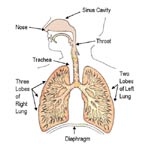RSV Symptoms in Infants
 RSV or Respiratory Syncytial Virus is a viral organism that causes infection in both upper and lower respiratory track. This virus is the most common cause of development of pneumonia and bronchitis in children up to the age of 1. The chances of a child developing RSV and consequently hospitalisation are much more as compared to flu. The main emphasis of the parents should be prevention of spread of this infection and the child should be made to wash hands using soap or some alcohol based hand sanitizer. If a child is being treated, even the health care person is advised to enter his room with protective gear as he is to get in contact with other kids also.
RSV or Respiratory Syncytial Virus is a viral organism that causes infection in both upper and lower respiratory track. This virus is the most common cause of development of pneumonia and bronchitis in children up to the age of 1. The chances of a child developing RSV and consequently hospitalisation are much more as compared to flu. The main emphasis of the parents should be prevention of spread of this infection and the child should be made to wash hands using soap or some alcohol based hand sanitizer. If a child is being treated, even the health care person is advised to enter his room with protective gear as he is to get in contact with other kids also.
Instances of RSV are more common during the months of spring and winter. In most of the cases a child can be treated as an outpatient. However, only severe or cases in which some complication has arisen may require hospitalisation. It takes one to two weeks for the patient to recover fully. The following types of children are more likely to be severally affected by RSV:
- Between the ages of 6 weeks to one year.
- Premature born children.
- Who have otherwise breathing problem or heart related problem.
- Who have weak immune system.
Causes
The main cause of a kid getting infected is by coming in contact with the infected child or material. Any type of body secretion has virus, the secretion could be from eyes, mouth or nose. Virus spreads in air due to sneezing or coughing of the infected child and remains alive in the atmosphere for many hours. It can remain alive on a toy or door handle for hours and on human hands for about 30 minutes. If a child touches the contaminated objects and then touches his mouth it will enter his system. When a child gets exposed, no symptoms may appear for about a week and when the symptoms appear the person may remain contagious for eight days.
Symptoms
The most common symptoms of RSV are:
- The child is lethargic, inactive and irritable.
- The intake of feed goes down.
- Child may develop fever as is common in viral infection.
- The child may develop apnoea and may not breathe for 10 seconds.
- Clear nasal discharge with nasal flaring and cough.
- Rattling in chest.
When a child develops any of these symptoms he should be taken to a doctor. The doctor will review the medical history of the child and physically examine him. Lab diagnosis will also be got done. Lab diagnosis includes culture of nasal discharge, chest X-ray and pulse oximetery done to measure the amount of oxygen in blood.
As the infection is caused by virus, antibiotics are ineffective for treatment. The doctor will treat the effect of virus on the respiratory system. Medicines can be given to reduce fever. The treatment also aims to make the life of the child easy. Treatment includes the following measures:
- To keep the child hydrated sufficient quantity of fluid should be given through mouth. In case the child does not take fluid from mouth and there are symptoms of dehydration intravenous infusion may be required.
- To open the airway of the child he may be treated under nebuliser.
- Supplementary oxygen may be given to the child through mask, nasal prong or an oxygen tent. This is also to help the child breathe easily and feel better.
- In severe case antiviral aerosol medication may be given or the child may be put on mechanical ventilation to make breathing easy.
No preventive vaccines are available. However preventive medicines can be given to high risk children during the period when the risk of infection are high i.e. during spring season and winter months. Also special care needs to be taken of the children who have weak immune system or are premature or have undergone some surgical process.